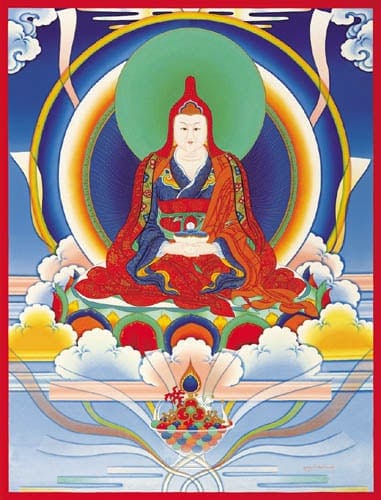Those of you who took the Path of Meditation Level 1 course will already be familiar with the practices presented here. In that program, you may have devoted significant time to practicing these techniques. That is excellent as our familiarity with them will help to enhance our main practices in this course. We are presenting these precious enhancing techniques again in this course as they should remain a crucial element in practitioner’s toolbox to be practiced as necessary.
When we practice meditation, we are developing a functional mind. The Buddha taught that as we practice meditation, our physical body should become light and pliable. To develop our mind and body in this way and to gain more concentration, we will now train in the Vase Breath.
The Physical Practice of Vase Breath
Begin by exhaling the breath. As you exhale, push your belly back toward your spine. Next, on the inhale, gently breathe in through your nostrils letting your breath travel down to your belly. When the inhale is complete, and settled low in the abdomen below the navel, we simultaneously gently push down on it from the top with our diaphragm and press up on it with our perineum and pelvic floor, much like doing a kegel exercise, similar to clenching the anus. We call this “vase” breathing because the breath remains like a rounded vase in the belly. As Rinpoche demonstrates, we should maintain the breath in the lower belly—beneath the navel—rather than in the chest.
As you very gently hold the breath there below the navel, keep your attention with the breath. This practice has many benefits—it improves your physical health. We also use vase breath in all levels of meditation training. Vase breathing keeps the mind fresh and relaxed. Gentleness is the key technique!
Do not do this practice soon after eating a meal. And if you feel any discomfort, do the practice more gently or take a break and resume when you are refreshed.
Practice Assignment
If you are brand new to Vase Breath practice, we suggest that you practice for at least 30 minutes to 1 hour or more a day for 1 month. Generally, we suggest two sessions per day—one in the morning and one in the evening.
If one has already done the above training, we should encourage ourselves to utilize this practice as necessary when facing relevant obstacles, but also simply from time to time to keep the practice fresh as we will return to it again in the future as our practice advances.
Bonus Material
We have added two extra teachings below in this section as an extra enhancement to your practice. You may apply these to enhance your practice and remove obstacles.
Overcoming Upper Body Physical Discomforts: Amrita Meditation
Sometimes when we practice meditation, we may feel tightness in the upper body. The ancient masters had specific techniques for overcoming this common issue. In this short bonus clip, Phakchok Rinpoche explains the antidote to anxiety and physical tightness in the chest.
Above the crown of our heads, we visualize a skull cup filled with warm and blissful oil. Don’t get overly concerned about the visualization—simply believe that it is there. It is brimming with a warm, pleasing oil. And then see this oil pouring slowly into the top of your head, through the fontanel, and then flowing straight down your central channel. At this point the oil enters the heart center and warms the heart. This should create a pleasant, blissful sensation. Continue this practice for about 5-10 minutes. If you are feeling tight, grumpy, fearful or anxious, this meditation can be very helpful. All these emotions are related to negative winds. The ancient mahāsiddhas recommended this practice to overcome these negative winds. Please practice this whenever you are feeling tight or anxious.
Guru in the Heart: Gurucitta
In this short video, Phakchok Rinpoche explains a second enhancing practice. This practice involves visualization of the guru in our heart center and is called “Gurucitta”. This visualization is a type of Guru Yoga practice. We can incorporate this daily as a supplication to help enhance our practice and remove obstacles.
Guru of Great Bliss Visualization
In our own heart center, we visualize a 8 petal lotus flower. Then atop the lotus petals, we visualize a flat moon disc. And on top of the moon disc, we visualize Guru Rinpoche, Padmasambhava, the size of our own thumb. Guru Rinpoche has two hands and holds a kapala and a long life vase with amrita. He wears a red pandita hat. We call this particular manifestation the Guru of Great Bliss. The Tibetan name is Guru Dewa Chenpo.
We then imagine that a large amount of amrita flows forth from the kapala in the Guru’s hands. This enters our own heart center and we experience great bliss. As we visualize this, we supplicate with the OṂ GURU MAHĀ SUKHA SIDDHI HŪṂ mantra, requesting the blessings.
Guru Padmasambhava Mantra:
OM AH HUNG BENZA GURU PEMA SIDDHI HUNG
Guru of Great Bliss Mantra explained in the video
OṂ GURU MAHĀ SUKHA SIDDHI HŪṂ


Responses